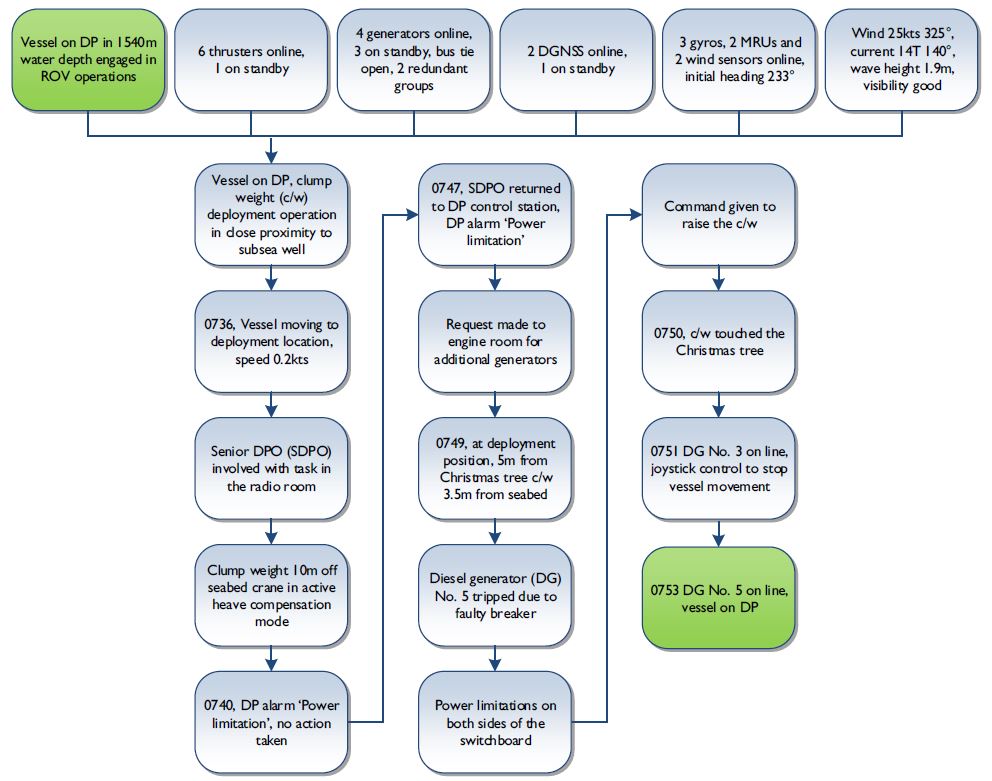Lack of planning and situational awareness causes – DP incident

Comments:
The event was investigated by the vessel operator, findings are summarised here:
Human factors:
- The DPO was left alone at the DP console during critical subsea operations. In such critical subsea operations, subsea lifting in vicinity of Christmas tree, both DPOs should have been 100% focused on current operations.
- Following the power limitation alarms, the DPO didn’t inform the SDPO, or request to start additional generators. Despite having wind and current pushing the vessel in the direction of the Christmas tree, he didn’t realize that the situation was becoming critical.
Processes and procedures:
- The activity specific operating guidelines (ASOG) was built up considering only vessel operations criticality and location (inside or outside the 500m zone), it failed to take into consideration the power consumption of ROV and cranes during these operations.
- The ASOG required only 2 DG on each bus bar. That means that YELLOW status (load >50%) would be reached earlier than with 3 DG per bus bar. The DPO and engineer on watch didn’t respect the ASOG as they didn’t react when YELLOW status was reached.
Equipment and design:
- The purpose of a micrologic breaker is to protect the electrical circuit from damage caused by excess current. In this situation, the breaker interrupted current due to misreading of the amperage. Preventive maintenance routines had been followed and increasing maintenance frequency would not prevent the kind of failure that affected DG No. 5.
Considerations from the above event:
- The power limitation alarm was active for 11 minutes, the power management system did not instigate an automatic start, therefore the FMEA and DP trials should be questioned.
- Neither the DPO nor engineer reacted to the situation and one DPO was left alone at the DP control station during a critical phase.
- Lack of preplanning and development of a separate ASOG for the task directly contributed to the event.
- The vessel is recorded as operating within DP equipment class 2, however only satellite derived position reference systems were recorded as being in use.
DP Event
Published: 2 November 2017
Download: IMCA DPE 04/17
Submit a Report
The following case studies and observations have been compiled from information received by IMCA. All vessel, client, and operational data has been removed from the narrative to ensure anonymity.
Case studies are not intended as guidance on the safe conduct of operations, but rather to assist vessel managers, DP operators and DP technical crew in appropriately determining how to safely conduct their own operations. Any queries should be directed to IMCA at [email protected]. Members and non-members alike are welcome to contact IMCA if they have experienced DP events which can be shared anonymously with the DP industry.
IMCA’s store terms and conditions (https://www.imca-int.com/legal-notices/terms/) apply to all downloads from IMCA’s website, including this document.
IMCA makes every effort to ensure the accuracy and reliability of the data contained in the documents it publishes, but IMCA shall not be liable for any guidance and/or recommendation and/or statement herein contained. The information contained in this document does not fulfil or replace any individual’s or Member's legal, regulatory or other duties or obligations in respect of their operations. Individuals and Members remain solely responsible for the safe, lawful and proper conduct of their operations.
